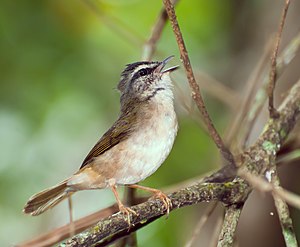River warbler
| River warbler | ||||||||||||
|---|---|---|---|---|---|---|---|---|---|---|---|---|

River warbler ( Myiothlypis rivularis ) |
||||||||||||
| Systematics | ||||||||||||
|
||||||||||||
| Scientific name | ||||||||||||
| Myiothlypis rivularis | ||||||||||||
| ( Wied-Neuwied , 1821) |
The river warbler ( Myiothlypis rivularis , Syn . : Basileuterus rivularis , Phaeothlypis rivularis ) is a small songbird of the genus Myiothlypis from the family of the wood warbler (Parulidae). This species forms a superspecies with the Schmätzerwald warbler ( Myiothlypis fulvicauda ) . The distribution area is in South America . The IUCN lists the bird species as "not endangered" (least concern).
features
The river warbler reaches a body length of 13.5 centimeters and a weight of 11.5 to 16.5 grams. The wing length is 6.1 to 6.9 centimeters in males and 5.9 to 6.5 centimeters in females. In the nominate form , adult birds and this year's young birds have a black forehead and black parting, the top of the head is slate gray and the narrow outer eye stripe is light grayish white and slightly yellowish-brown. The eye stripe is blackish and the interrupted eye ring is light yellow-brown. The olive-brown ear covers are streaked with indistinct light beige and white stripes. The nape and sides of the neck are slate gray and the upper side plumage is dark olive; The rump and upper tail-coverts are lighter olive. The wings are dark brown with olive feather edges, the control feathers dark olive with lighter olive feather edges.
The throat plumage is light beige-white, the breast light yellow-brown with dark olive-washed breasts. The abdomen, the dark olive washed flanks and the under tail covers are clearly yellow-brown, whereby the center of the abdomen can sometimes be whitish. The beak is blackish and the legs are flesh-colored.
When young, the birds are very similar to the young birds of their sister species, the river warbler. The only distinguishing feature is the missing yellow-brown base of the tail.
Habitat, Nutrition and Reproduction
The species is a resident bird and inhabits lowlands in rainforests, forest edges on marshland and areas along rivers and streams up to a height of 1000 meters. The subspecies Phaeothlypis r occurs in the foothills of the Andes in Bolivia . boliviana also occurs up to an altitude of 1400 meters. The birds prefer slow-flowing waters and more wetlands with standing water than the river warbler.
For their food, consisting of insects and other invertebrates , they usually hop in pairs on the ground and on lying dead wood, mainly at the edges of water. Sometimes they catch their prey in flight from the ground. The tail swings steadily back and forth and bobs up and down.
There is little information about the breeding season. Fledglings that had just fledged were sighted in Brazil in March, April and July , and in Venezuela individuals were heard singing in February.
There is a report of a hybrid with the olive-flanked warbler ( Basileuterus leucoblepharus ).
Systematics and distribution
Three subspecies are recognized that occur in clearly separated regions:
- Myiothlypis r. rivularis ( Wied-Neuwied , 1821) - Found in the southeast of Brazil, in the east of Paraguay, and in the extreme northeast of Argentina .
- Myiothlypis r. boliviana ( Sharpe , 1885) - Widespread in the foothills of the Andes in Bolivia. This subspecies resembles the nominate form in appearance. The parietal stripe is missing, the outer stripe is shorter and a little stronger yellow-brown and the underside plumage is visibly more intense white.
- Myiothlypis r. mesoleuca ( PL Sclater , 1865) - Occurrences are found in the east of Venezuela and in Guyana , Suriname and French Guiana, as well as in the eastern Amazon basin in northeastern Brazil. The upper side plumage is lighter and more brownish-olive than in the other two subspecies. The over-eye stripe, the eye ring and the ear covers are more intense yellow-brown. Also in this subspecies the black side stripe is missing. The underside plumage is more intensely colored: the throat and the belly are white and the chest, the flanks and the under tail-coverts are bright yellow-brown.
swell
literature
- Jon Curson, David Quinn, David Beadle: New World Warblers. Helm, London 1994, ISBN 0-7136-3932-6 , pp. 90 and 229.
Web links
- Myiothlypis rivularis inthe IUCN Red List of Threatened Species 2016.3. Posted by: BirdLife International , 2016. Retrieved February 1, 2017.
- BirdLife International: Species Factsheet - Myiothlypis rivularis . Retrieved February 1, 2017.